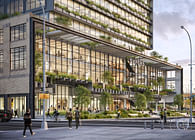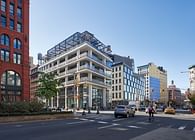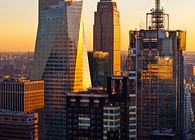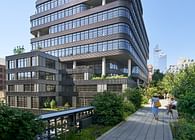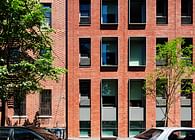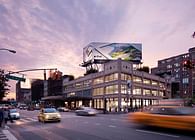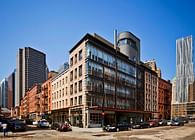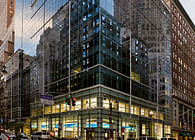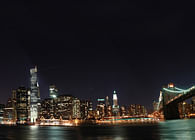
New York, NY
New York City, like other metropolises of many millions of people, has both great environmental advantages and serious ecological impacts. While well-known for its relatively low energy use per capita and highly successful public transportation system, in the summer the city becomes a sweltering landscape of concrete, brick, and steel. Its roofscape is largely a field of black tar surfaces that soak up sun and shed stormwater to the pavement below.In the summer of 2006, COOKFOX decided to set a greener, healthier example with a roof that absorbs stormwater, fights the urban “heat island” effect that burdens the city’s energy infrastructure, and benefits both the local ecosystem and the human environment. Located in the 8th floor penthouse of a former upscale department store, in the Ladies’ Mile Historic District, the space looked onto a sizeable terrace-level rooftop. Though coated in black tar and formally off-limits, the roof held great potential as a platform for promoting urban sustainability.Our office wanted a green roof that would be lightweight, flexible, low-maintenance, and affordable. Built in 1902 of sturdy masonry construction, the roof was judged capable of handling an additional load; however, the firm and its landlord wanted to minimize additional weight. While the owners of the building were open to the proposed green roof, they were concerned about the integrity of the roof membrane and building drainage system. For these reasons, we were interested in a flexible system that could be altered later if necessary. With a non-rectilinear area for planting, small modular units, filled with a mix of expanded shale (80%) and compost (20%), offered the best options for creating a green roof in a custom shape.InstallationEarly August 2006 representatives from Green Roof Blocks and Jost Greenhouses traveled from St. Louis to supervise the installation of the green roof. Some 5000 plant seedlings arrived separately, transported from Emory Knoll Farms in Maryland by biodiesel-powered truck. Over 800 Green Paks, each weighing 55 pounds, were filled with growing medium at McEnroe Organic Farm—whose owners are longtime friends of the firm—in Millerton, New York and trucked to Manhattan to be met by 25 volunteers from COOKFOX.Our staff hoisted the packs to the 8th floor, out a window, and onto the roof, where they were laid down over a half-inch drainage mat, which also acts as a root barrier protecting the roof membrane below. Once laid flat, the bags measured four inches deep; holes were made and a slow-release plant food added to prepare the bags for planting. Meanwhile, another team of volunteers prepared the eight species of sedum and one of talinum and gently dug them into the shale-and-soil aggregate, placing six plants per bag. To foster the greatest biodiversity and resilience in the new ecosystem, the team mixed the seedlings so that no two individuals of the same species were planted next to each other. The young plants then received a thorough initial watering. Following the landscape installation, the roof design was finished with high-albedo pavers surrounding the inner plantings and smooth gravel lining the curving window wall.As one of the few sizeable green roofs in Manhattan, the project offers an excellent opportunity for ongoing research on planted roofs in dense, urban areas. COOKFOX is collaborating with the nonprofit Gaia Institute to study water retention and growth rates of the sedums, using methodology developed by the Southern Illinois University - Edwardsville Green Roof Collaborative.Biophilia: Benefits of Restoring the Human EnvironmentBecause the green roof is at the 8th floor terrace level, not overhead above the 8th floor, COOKFOX does not capture the energy savings associated with the cooling effects of the green roof; instead, these savings benefit the tenants of the 7th floor. Even so, installing a green roof was one of the best decisions made. As Rick Cook explained to Metropolis magazine in November 2006, “Every business knows how destructive it is when people are unhappy…and how productive – and profitable – it is when the staff is invested.”The field of research known as biophilia – a term popularized by E.O. Wilson and defined as “love of life” or the innate kinship that humans feel toward the natural world – explores what it means to design the built environment to foster positive connections with nature. Contact with the natural world, both literal and symbolic, has been shown to reduce stress and even enhance employee health and productivity. In an office environment, biophilic design strategies can translate into reduced absenteeism and turnover, and lead to a more productive, creative work environment.To many, restoring ecosystems to the point of supporting wildlife may seem like a lost cause in a place like New York City. However, even small areas of open space can support thriving populations of microorganisms, flora, and fauna, and these oases of biodiversity help sustain larger urban ecosystems. Almost immediately after installation, we discovered insect life returning to the green roof. Dragonflies were the first to appear. In early September, the first bird was spotted. Later, hawks were noticed using the roof railing as a perch and throughout the fall, monarch butterflies often visited during their semiannual migration.Very much a living horizon, the green roof breaks up the urban backdrop of tall buildings and densely packed vehicles. This restorative green plane is a constant presence in the office, drawing the outside environment into the sightlines of the workplace. The roof also marks the changing seasons and the time of day. Employees are naturally more aware of dry spells, frost snaps, and other weather impacts on the micro-ecosystem out the window. In addition to illustrating ecological concepts to clients and visitors, the green roof has become a defining feature for the entire office. In a city where daily contact with open space is often a rare amenity, even a small patch of greenery can start knitting the urban ecosystem back together and give living things a place in the human environment.Excerpt from the article “Monarchs in Metropolis: A Case Study of the Cook+Fox Architects Green Roof” by Alice Harley, LEED AP.
Status: Built
Location: New York, NY, US
